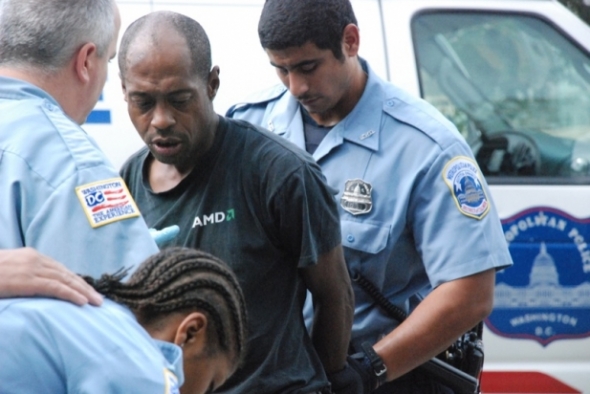Once upon a time, alarms detected burglars, officers responded and police made arrests. Underwriters depended on "loss control with a badge."
In fact, underwriters created the security industry in the early 1900s when they wired a problem Boston bank that then alerted the nearby telegraph office of a burglary. Police arrested the burglars and prevented a large claim.
Underwriters built upon this success and pushed policy holders to install burglar alarms because they worked — police made arrests and lowered claims. The alarm/police response concept worked so well that underwriters soon mandated that all high-value policy holders such as banks and jewelry stores install UL certified intrusion alarms before issuing a policy. They also created alarm discounts in their policy contracts to encourage their other commercial and residential policy holders to install burglar alarms.
This historic police/alarm/insurance model boosted profits through the 1970s, but the partnership lost its value, deteriorated and died. Before we resurrect this partnership and reconsider the "alarm discount," we need to understand what happened.
Background
What caused "loss control with a badge" to fade?
From the underwriter's perspective, the unprecedented bull market of the 1980s meant that profitability shifted away from loss control to a focus on collecting premium and driving investment-income. At the same time from the alarm perspective, the digital phone dialer appeared and opened a new mass market for inexpensive burglar alarms. The installed base of traditional alarm systems exploded into the tens of millions, creating a tsunami of false alarms for law enforcement that eroded value. With a staggering false alarm rate of over 98%, police now considered traditional alarms a waste of resources and response decayed. Officers no longer made arrests as alarm companies focused on selling "deterrence" instead of apprehensions. From the police perspective, they simply no longer cared.
The situation degraded to the point that major cities like Las Vegas, Salt Lake City, and Milwaukee stopped responding to traditional burglar alarms altogether. This trend towards declining alarm response continues to be an issue. The police/alarm/insurance partnership had atrophied and neither the police nor underwriters saw value in traditional burglar alarms.
The Problem
Before we consider the solution, let's look at how traditional alarms are viewed by police. When hit with budget cuts, Detroit Police joined the growing trend and decided to end response to traditional alarms because there simply weren't enough officers to go around anymore. Traditional alarms no longer delivered.
On August 16, 2011 in a Detroit Free Press feature article, Detroit Police Chief Ralph Godbee Jr. declared that any triggered alarm will require a verified response before dispatch sends a cruiser to the location. Godbee cited a US Department of Justice report supporting verified response as a reliable practice towards eliminating waste and improving public service. Abandoning traditional alarms, Chief Godbee sees video verified alarms as the solution to more effective policing — using video to verify that the alarm is an actual crime. Detroit Police Commander Todd Bettison stated, "Our main goal is to respond to crime, and if we can utilize modern technology, then so much the better. We feel very passionate about this. We've been looking at this for a long time and from what we've observed this is definitely the way to go."
One program developed by the security industry to address this "false alarm problem" was to transform false alarms into a municipal revenue stream — creating city ordinances mandating false alarm fines and permits for burglar alarms.
While filling the city's coffers with false alarm fines may placate city councils, this approach does very little to increase arrests and address the need for effective loss control. In any case, in many jurisdictions this program is simply overwhelmed by draconian budget cuts that are decimating the ranks of law enforcement.
The recent Department of Justice publication, "The Impact of the Economic Downturn on American Police Agencies" stated that at least 10,000 officers had been laid off in 2011. In the last two years, the San Jose Police Department has reduced its officers by 20% — forcing them to reconsider alarm response.
In a memorandum sent to the City Council's public safety committee in December 2011, police Chief Chris Moore wrote that, "the primary purpose of police is to respond to reported crimes, preventive patrols and community policing, and the practice of responding to all audible alarms does not accomplish any of those goals." Chief Moore further underscored just how ineffective traditional alarms were at delivering apprehensions: "In 2011 San Jose had 12,450 alarm calls and of those there were only 2 arrests."
These statistics are not unique. According to the Las Cruces Sun-Times, Las Cruces, New Mexico is moving towards verified response after reviewing that in 2011 a total of 12,970 alarm runs resulted in only 2 burglars being arrested. In light of such statistics, San Jose, California went forward and implemented a verified response policy on January 1, 2011. City leaders say the new policy will allow police to focus on high priority calls and perhaps even reduce those response times.
This is the real benefit of verified response to underwriters — policy holders who use video verified alarms actually get faster response for more arrests. Police attention is focused on crimes-in-progress instead of on false alarms.
Most underwriters are not aware that police don't respond to traditional alarms in many areas of the country. Politicians avoid public outcry, and degraded alarm response policies are often presented in "politically friendly" code but the result is the same — no police response and higher claims.
"Broadcast and file" is one example of a "friendly" sounding non-response policy that is popular in Colorado and the West. For many large Colorado cities like Denver, a "broadcast and file" policy means that alarms are simply broadcast over the radio and an officer responds if he feels like it, and has nothing else to do. It is "voluntary response."
The majority of the time this means no response at all. In contrast, video verified alarms still receive mandatory dispatch in "broadcast and file" jurisdictions and deliver real value and arrests. Many police departments have simply relegated traditional alarm response to such a low priority that the response time is measured in hours not minutes.
Underwriters have not been totally ignorant of this trend towards degraded response. Large companies like State Farm and Allstate have already eliminated the "alarm deduction" in Florida and underwriters are moving to remove it from their contracts nationwide because they can no longer afford what has become a "marketing device" that has no impact on reducing claims.
The Solution
The alarm industry and law enforcement have a solution — new technology and updated policies. Video verified burglar alarms have resurrected the police/alarm response model. Police are making arrests again and changing the paradigm. The June 2012 cover story of SDM Magazine, "Does All of This Stop Crime?", cited examples of amazing arrest rates using video alarms. Universal monitoring, an alarm company in Charlotte, achieved over 60% arrest rates on their monitored video alarms in a one year period. F.E. Moran, an alarm company in Illinois, delivered 129 arrests for 136 incidents using video alarms protecting commercial property — over a 95% arrest rate!
The March 2012 issue of IACP (International Association of Police Chiefs) Police Chief Magazine documents a case study of this new approach at Detroit Public Schools in an article entitled, "Arresting Results: How One District Achieved a 70 Percent Closure Rate with Video Alarms." Detroit Public Schools installed video intrusion alarms in 30 vacant schools that were targets of vandalism and copper theft. During the 2010/2011 school year, there were 101 burglaries in these facilities. According to the report, the police closed 70 incidents with arrests of 123 people — a 70% arrest rate.
From an underwriter's point of view the results change the game — a few thousand dollars for video alarms saved millions in damage for Detroit Public Schools. In fact, Detroit officer John Greene made over 150 arrests using video intrusion alarms and was named officer of the year in Police K-9 Magazine.
These results are not unique — video intrusion alarms are delivering arrests across the country, saving insurers millions.
In February 2012, the Los Angeles County Sheriff's Department, speaking of their new Priority Response program, announced initial arrest rates of 19% for video intrusion alarms. In contrast, the 2011 burglary arrest rates (without alarms) in Dallas and Minneapolis were 5.2% and 7.3% respectively. Even more worrisome, a study by the San Bernardino Police and Sheriff in 2007 reported an arrest rate of 0.08% for traditional alarms. For San Jose it was less than 2 arrests for every 10,000 alarm runs in 2011.
It is ironic that insurance companies continue to offer costly "alarm discounts" in cities that no longer respond to alarms that no longer deliver arrests.
An underwriter knows that putting one burglar in jail prevents an additional 30-50 burglaries they would have committed on the street (as well as eliminating the cost of the entire claims process incurred by the company). A single site in Chandler, Arizona protected with video intrusion alarms resulted in over 40 arrests in 4 months according to an article in Modern Contractor Magazine.
While response to traditional alarms is decaying, video verified alarms are transforming security and providing new value to law enforcement and underwriters. Alarm monitoring companies are even sending video clips of the intruders to police cell phones, making them even more effective. This is making a dramatic difference in combatting property crime, a paradigm shift for police and sheriffs. Video alarm technology and Priority Response has created an inflection point in an insurance market demanding the return to modern loss control.
It is also a new world for law enforcement. Both police and sheriffs embrace solutions that deliver arrests and make them more effective. Law enforcement sees video intrusion alarms as a fundamental paradigm shift and they want to encourage them, so much so that they are directing the 911 dispatch centers to create special dispatch codes that designate video alarms for high-priority response. In essence, the 911 operators treat video verified alarms as a crime-in-progress, not just an alarm.
Priority Response to video alarms means that the historical police/alarm concept has value for underwriters and works again protecting property and reducing losses. Police respond to video alarms and make arrests that reduce claims. Law enforcement is being proactive, encouraging their citizens to help them protect their property. Chief Steve Dye, of Grand Prairie, Texas recently announced a Priority Response policy on a televised newscast and sent flyers in the water bills of Grand Prairie property owners encouraging them to upgrade to video alarms. Sheriff Larry Amerson of Calhoun County wrote a letter to his constituents, "We believe that video alarms offer enhanced protection to you and help us in our efforts to keep Calhoun County citizens safe and protect their property."
Law enforcement is making arrests again, and it matters. The National Sheriffs Association even officially endorsed the video alarm manufacturer, Videofied, the first endorsement of a burglary alarm by national law enforcement — because they deliver more arrests.
It is a new world for underwriters. Loss control matters again. It's a world that is ripe for the rebirth of the police/alarm/insurance partnership. Underwriters need loss control — the stock market crash and economic downturn have radically impacted the insurance business model and profitability. Pat Speer, editor of Insurance Networking News, spoke of alarm systems in her January 2012 column, "Is Loss Control a Lost Art?" She concludes her article with, "Given the cost dynamics of the industry's long history of successful loss control initiatives, holding clients contractually accountable for known risk management prevention efforts is just logical. Isn't it?"
Underwriters are again forced to price policies that depend upon loss control for profitability. To strengthen the point, the downturn has created new crime categories, such as copper theft, that leave insurers with expensive property claims 20 to 30 times greater than the scrap value of the stolen copper — recovery is impossible when stealing $1,800 of copper creates a loss of $85,000 for broken plumbing, wiring and HVAC. CBS News recently reported on copper theft at a dental office in Sacramento where thieves caused over $10,000 in damage for $200 of copper.All this pressure on profitability comes at a time when the premium base is actually shrinking. With the proverbial financial gun to their heads, underwriters are looking to resurrect "loss control with a badge."
Reconsidering The Alarm Discount
Underwriters are becoming educated. Experience has taught them that video surveillance is not loss control. Most surveillance is NOT monitored in real time. It is true that high definition CCTV surveillance cameras and a video recorder can document a theft in high resolution for later review by the business owner. This may be interesting for a television audience, but for the underwriter the crime has already happened, the building is damaged and the crook is long gone with the loot.
Movie-quality video without real time monitoring and immediate police response is a solution, but for other problems. Video quality is not the key issue — once the monitoring operator can tell that there is an actual crime and sends the police — that is enough. There are hundreds of video clips of arrests on YouTube taken outdoors and in difficult low-light conditions that prove the point.
"Adequate video quality" means affordability and the good news is that video intrusion alarms themselves are now the price of a traditional system and much less expensive than a high definition surveillance system. Police don't need Hollywood quality to make arrests — what they need is instant notification of a crime-in-progress.
Underwriters know they must answer the question, "How can we encourage policy holders to use video alarms and police response to reduce losses?"
One simple approach is to review the existing alarm discounts and limit them to video intrusion alarms that deliver Priority Response. Practically speaking this means working with an alarm company as a partner that provides video verification services. Effective loss control means that video clips of the burglary are sent to a monitoring station where they are immediately reviewed and dispatched as crime-in-progress.
A longer term approach being coordinated by the PPVAR (Partnership for Priority Video Alarm Response) is to bring the insurers, law enforcement and security companies together to begin to develop guidelines and standards that could be used by underwriters for specific markets and applications. The board of the PPVAR is composed of representatives from the Police, Sheriffs, the National Insurance Crime Bureau, and the Alarm Industry. This security/insurer/law enforcement working group will analyze loss data for specific applications, such as construction, and create guidelines for minimum requirements needed to actually bring the police and stop the losses — an updated reincarnation of certificated alarm systems.
In any case, the alarm industry and the PPVAR are reaching out to insurance industry associations including the CPCU (Chartered Property Casualty Underwriters), the NICB (National Insurance Crime Bureau), ISO (insurance Services Corporation), PIAA (Professional Insurance Agents Association), and others to educate them and solicit their support as we attempt to resurrect the partnership that worked so well in the past — security companies installed alarms, police made arrests, and insurers reduced loss.
Additional Resources
For more information on the PPVAR: www.priorityresponse.info
CPCU webcast training is available at www.cpcusociety.org/page/184331/
NICB 6 minute video overview: www.ijmag.com/LossControl





